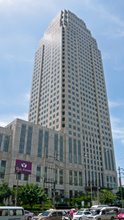
Profits from condo to spur new projects. Few property companies listed on the Stock Exchange of Thailand have the diverse portfolio of industrial, residential and infrastructure endeavours that Hemaraj Land and Development has.
Its most noteworthy luxury-condominium project, The Park Chidlom, in Soi Somkid, is almost completed. It is expected to inject about Bt4 billion into its coffers when the units are transferred later this year, Hemaraj's CEO David Nardone said.
"After paying off debts of about Bt1.8 billion, The Park Chidlom will still bring in Bt2.2 billion in net profit," Nardone said. "The money will be used for investment in new ventures and as operating cash."
Residential development represents but quarter of Hemaraj's operations while 40 per cent of its business is industrial estates.
Hemaraj operates six industrial estates.
Its latest addition is the Hemaraj Eastern Seaboard Industrial Estate, which straddles Chon Buri and Rayong.
The others are Hemaraj Chon Buri Industrial Estate, Hemaraj Eastern Industrial Estate in Map Ta Phut, Eastern Seaboard Industrial Estate in Rayong, SIL Industrial Land in Sara Buri and Rayong Industrial Land.
They employ 50,000 people, more than 95 per cent local, Nardone said.
Because of growing demand for manpower from the 340 companies - among them global giants such as General Motors, Ford, Isuzu, Chevrolet, Opel, Bridgestone, Kelogg's and BASFd - the estates provides key infrastructure such as schools, housing, water and electricity to keep workers and their families stationed there.
"We even provide land for a police station and other public offices," Nardone said.
Hemaraj offers seven scholarships, four for universities and three for vocational schools, to students on the estates.
"Most of the workers come from the poorest part of Thailand, the Northeast, and the scholarships go to youngsters who need them," said another Hemaraj executive.
Hemaraj sees the Kingdom moving forward steadily despite recent political shocks because the groundwork that has gone into developing the Eastern Seaboard in the past 25 years is now paying off.
Not many people realise that Laem Chabang ranks among the world's top 20 ports, Nardone said. Allowing private concessions to operate the docks has certainly enhanced quality and efficiency, he noted.
Also underestimated is the steady increase in industrial land utilisation. The pace surprises Nardone himself. "We projected 725 rai for this year. We have had to revise that to 800 rai and then revise that to 1,000 rai because the take-up rate for the first quarter alone was already 500 rai."
With the quiet expansion of local and foreign conglomerates in the industrial parks, Nardone said, the stage is set for even stronger growth ahead.
Yet he is critical of the poor handling of new regulations on foreign businesses.
To attract foreign investment, the government must demonstrate "an open and consistent playing field for foreigners", he said.
"Luckily, manufacturing-investment plans in key industries implemented over the last 25 years ... have left Thailand in a strong and competitive position both domestically and regionally for many years to come."
While there are dangers that emerging economies such as Vietnam will soon catch up with the Kingdom's economic might, he said, comparisons should be made in a level-headed manner.
"The demand for cars in Vietnam is about 40,000 a year. On our industrial estates the combined output is two million a year."
The one area which Hemeraj is moving quickly to tap is infrastructure industries such as fresh water, electrical power and the construction of efficient factories.
"Hemaraj is basically a company of engineers," Nardone said. One of the company's more outstanding creations is a natural waste-water system that uses natural vegetation to treat waste water. The organic method uses plants to absorb waste matter, including metals. Cleaning waste water requires large areas for the ponds the treated water is filtered through. At Hemaraj's facility the area covers 700 rai.
"The method was developed by one of our directors, Vivat Jiratikarnsakul," he said The original idea was that of His Majesty King, added a staff member. Hemaraj works closely with the Asian Institute of Technology on ways to improve the environment using eco-friendly systems.
Source: The Nation


No comments:
Post a Comment